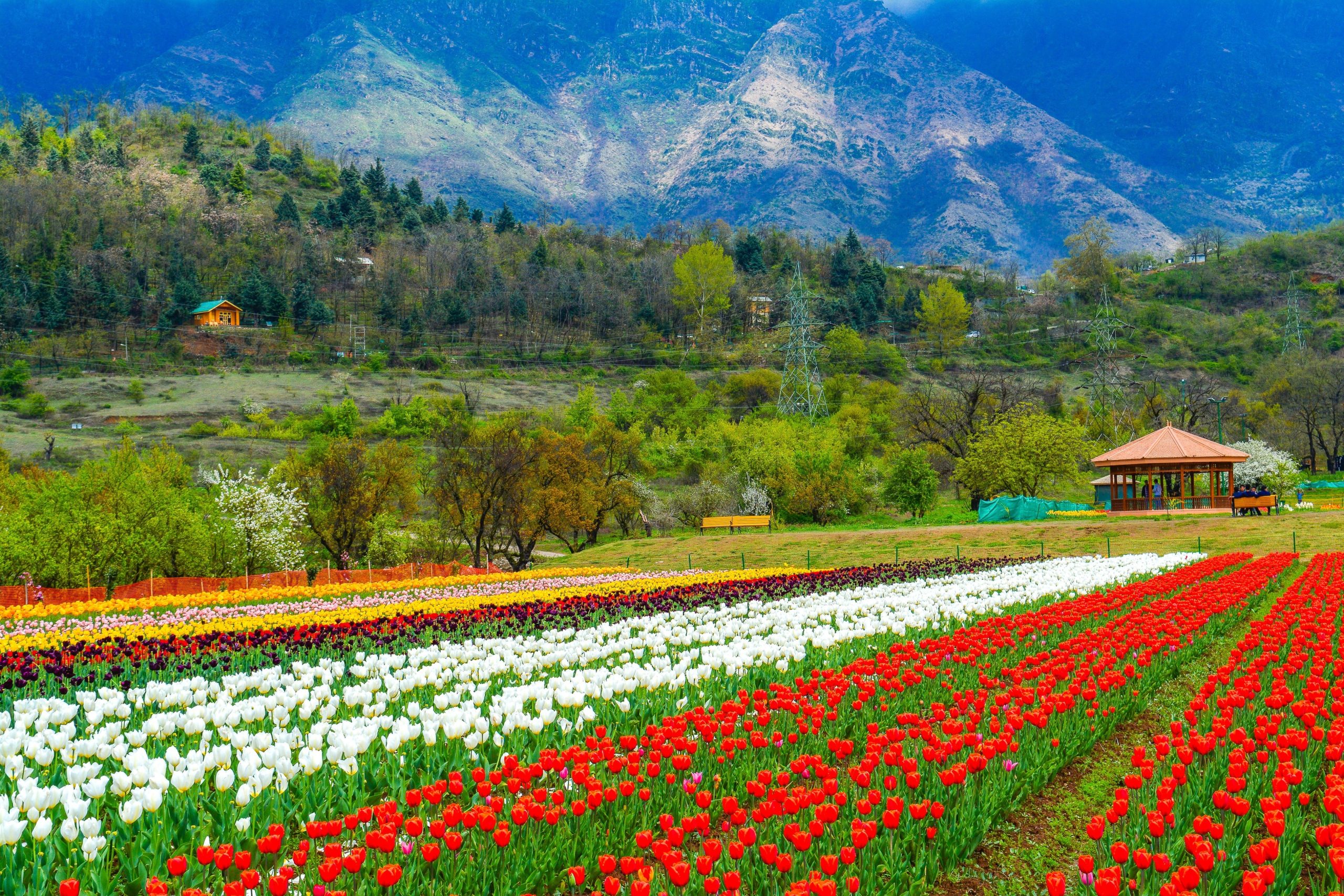Kashmir, known as “Paradise on Earth,” is a land of breathtaking landscapes, lush valleys, snow-capped mountains, and pristine lakes. Among its many wonders, the gardens of Kashmir stand out as unique treasures, celebrated for their rich history, stunning beauty, and diverse flora. From the meticulously designed Mughal Gardens to the vibrant Tulip Festivals, these green spaces offer a serene escape into nature and history. For travelers seeking both tranquility and a cultural experience, a visit to Kashmir’s gardens is an essential part of their journey.
The Mughal Gardens: A Glimpse into History
The Mughal Gardens of Kashmir are the epitome of architectural splendor and horticultural excellence, designed to represent the harmony between human creation and nature. Dating back to the 16th century, these gardens were developed under the reign of the Mughal emperors, who sought to recreate the Persian concept of paradise in the verdant valleys of Kashmir. The result was a series of terraced gardens that combine symmetrical layouts with natural elements such as water, flowers, and mountains.
During any Kashmir trip, a visit to the Mughal Gardens is a must. These gardens are not only beautiful but also steeped in history, providing a glimpse into the grandeur of the Mughal Empire. The most famous of these gardens include Shalimar Bagh, Nishat Bagh, and Chashme Shahi.
Shalimar Bagh: The Garden of Love
Shalimar Bagh, also known as the “Abode of Love,” was built by Emperor Jahangir in 1619 for his beloved wife, Nur Jahan. This garden is the largest of the Mughal Gardens in Kashmir and is a stunning example of Persian-style landscaping. Divided into three terraces, each offering a different view of the Dal Lake and surrounding mountains, Shalimar Bagh features flowing water channels, fountains, and flowerbeds that create a soothing ambiance. During a Kashmir trip, the sight of the garden in full bloom, with colorful flowers lining the water channels, is truly mesmerizing.
Nishat Bagh: The Garden of Bliss
Nishat Bagh, meaning “Garden of Bliss,” is another exquisite creation of the Mughal era. Built by Asif Khan, the brother of Nur Jahan, in 1633, this garden is the second-largest in Kashmir and is situated on the eastern side of Dal Lake. Like Shalimar Bagh, it follows the traditional Persian garden layout with terraced levels, but its unique charm lies in the sweeping views of the Zabarwan mountain range. Visitors to Nishat Bagh will find themselves surrounded by fragrant flowerbeds, tall Chinar trees, and meticulously maintained lawns, making it a perfect spot for a leisurely stroll during any Kashmir trip.
Chashme Shahi: The Royal Spring
Chashme Shahi, the smallest but perhaps the most charming of the Mughal Gardens, was built in 1632 by Emperor Shah Jahan as a gift for his son, Dara Shikoh. The garden is famous for its natural spring, which is said to have medicinal properties. Visitors can enjoy the soothing sound of water flowing through the garden’s beautifully crafted terraces, and the location offers panoramic views of Dal Lake and the surrounding hills. Chashme Shahi is particularly lovely during the spring and summer months, when the flowers are in full bloom, creating a vibrant atmosphere that draws travelers from all over.
Tulip Festival: A Riot of Colors
Every spring, the Indira Gandhi Memorial Tulip Garden, nestled at the foothills of the Zabarwan Range, transforms into a sea of vibrant colors as millions of tulips bloom in harmony. The Tulip Festival, held annually in Srinagar, is one of the largest tulip festivals in Asia and attracts thousands of visitors who come to witness this extraordinary display of nature’s beauty.
The garden, spread over 30 hectares, boasts over 60 varieties of tulips, each displaying a unique array of colors and patterns. From fiery reds and oranges to soft pinks and purples, the garden offers a breathtaking sight, enhanced by the snow-covered peaks in the background. The Tulip Festival is not only a feast for the eyes but also a celebration of Kashmiri culture, with local handicrafts, traditional music, and delicious cuisine on display. For anyone visiting during the spring, this event is a highlight of their Kashmir itinerary.
Botanical Gardens: A Haven for Nature Lovers
In addition to the Mughal Gardens and the Tulip Festival, Kashmir is home to several botanical gardens that showcase the region’s rich biodiversity. The Jawaharlal Nehru Memorial Botanical Garden, located near the Chashme Shahi Garden, is one such haven. Established in 1969, this garden is dedicated to preserving Kashmir’s indigenous plant species and promoting environmental awareness.
The botanical garden is home to a variety of plants, including rare and endangered species. Its sprawling lawns, dotted with colorful flower beds and ornamental trees, offer a tranquil environment for visitors to relax and enjoy the natural beauty of Kashmir. The garden is also home to a large collection of oak varieties, making it a significant site for both botanical research and tourism.
Pari Mahal: The Abode of Fairies
Perched on a hilltop overlooking Dal Lake, Pari Mahal is a stunning example of Mughal architecture blended with Islamic influences. Originally a Buddhist monastery, it was converted into a garden and observatory by Dara Shikoh, the eldest son of Emperor Shah Jahan, in the mid-17th century. Pari Mahal, also known as the “Palace of Fairies,” is characterized by its multi-level terraces, each offering a unique view of the surrounding landscape.
The garden is not as lush as the Mughal Gardens, but its historical significance and architectural beauty make it a must-visit during a Kashmir trip. The panoramic views from the top terrace, where you can see Dal Lake, Srinagar city, and the distant Himalayan peaks, are simply breathtaking.
The Charm of Kashmir’s Local Gardens
While the Mughal Gardens and the Tulip Festival are the crown jewels of Kashmir’s horticultural scene, the region is also dotted with smaller, lesser-known gardens that offer their own unique charm. For example, the Achabal Garden, located in the Anantnag district, is a beautiful terraced garden that was commissioned by Empress Nur Jahan. With its fountains, pavilions, and serene atmosphere, Achabal is a peaceful retreat for those seeking to escape the more crowded tourist spots.
Verinag Garden, another lesser-known gem, is located at the source of the Jhelum River and is one of the earliest Mughal Gardens in Kashmir. It is famous for its octagonal spring, which has been a source of inspiration for poets and artists throughout history.
Conclusion
Kashmir’s gardens are a testament to the region’s rich cultural history and its deep connection with nature. From the meticulously planned Mughal Gardens to the vibrant displays of the Tulip Festival, each garden tells a story of beauty, tranquility, and artistry. Whether you’re a history enthusiast, a nature lover, or simply looking for a peaceful retreat, exploring the gardens of Kashmir during your Kashmir trip is an experience that will leave you enchanted and inspired




